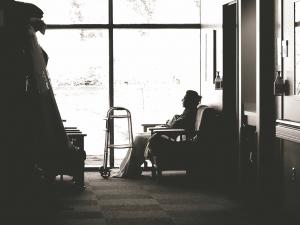Respiratory physician Lutz Beckert considers chronic obstructive pulmonary disease management, including the prevention of COPD, the importance of smoking cessation and pulmonary rehabilitation, and the lifesaving potential of addressing treatable traits. He also discusses the logic of inhaler therapy, moving from single therapy to dual and triple therapy when indicated, as well as other aspects of management
‘We’re all smashed’: Melbourne GP describes Omicron onslaught
‘We’re all smashed’: Melbourne GP describes Omicron onslaught

“[Queensland] is smashed more because the state government had no real scheme to involve general practice”
Victoria GP Mukesh Haikerwal’s large medical centre in western Melbourne had to reduce services briefly several weeks ago because so many staff were off as Omicron cases or contacts.
“Last year, up until the peak started happening, we would have had 80 or 90 COVID-19-positive cases [among patients] till December and no staff absent or ill.
“With Omicron and the coming-down of barriers around Christmas and New Year, especially New Year, we went through a time when 28 of our 40 staff were off.”
Dr Haikerwal is a director and GP at Altona North Medical Group, which includes a general practice and a general practice-led respiratory centre. It provides COVID-19 swabbing and vaccination and now also checks people with rapid antigen tests (RATs).
“We had to cancel vaccination clinics for kids, we had to reduce capacity to do COVID testing and care, and in the general medical practice we lost doctors, we lost staff…so we had to shut down the front doors. We had to [consult] only by telehealth. Only if a doctor assessed someone as being safe to come into the building and escorted them in, and looked at them in their rooms and back out again would we have face-to-face.”
It was a greatly diminished service, Dr Haikerwal says. But other clinics had suffered more, having to close completely for a time.
His medical centre has even had to moderate the policy which previously didn’t allow COVID-exposed staff to return until they produced a negative RAT result on day six. “[Otherwise] we would have had no staff.
“…We will let them come back to work, but they have got to stay in their room and do telehealth. If they have to see someone it has to be in the carpark in full PPE, not in the room; if they do come to the room, the doors have to be open and they have to leave space for people, understanding there is a chance they could turn positive.”
Victoria’s case numbers seemed to peak at more than 51,000 a day three weeks ago. This week, the daily tallies have been under 16,000, although that is still many times the daily Delta tallies of last year.
Dr Haikerwal believes New Zealand is in a good position to respond well to Omicron because of its high rate of enrolment in primary care and lack of some of the bureaucratic problems that prevent many COVID cases in Australia being notified to their GPs. Automatic notification to GPs’ inboxes is key, he says.
“My colleagues in Queensland are smashed. We are all smashed. They are smashed more because the state government had no real scheme to involve general practice.”
He says there are many unvaccinated or newly double-vaccinated Omicron cases who would probably be eligible for monoclonal antibody therapy but don’t receive it because of uncertainties over who has been tested. This is exacerbated by uncertainty over results, “and because they don’t have a GP who knows the patient to identify if they might have a chronic disease or compromised status and therefore need to have these infusions to reduce the devastation of the disease”.
But because Dr Haikerwal’s medical centre provides testing, now including RAT testing, it knows who its positive cases are and can identify those who may benefit from drug treatments which have to be started early.
He also has some advice on the RAT testing under Australia’s seven-day isolation period for cases. New Zealand will move to seven days for contacts and 10 days for cases (from 10 and 14 days now) when Omicron cases ramp up.
“The tricky one is, you’re in a house, someone is positive, you do a RAT and you’re negative. If you’re double vaccinated what we’re finding is they will usually turn positive on day four or six. If they go to day six and they are negative, they are completely free from worrying about COVID for the time being.
“If they are positive at day six, the seven days’ starts at day six and it’s 13 days. Our advice has been to get a RAT test at least at day four if not day two, because it will probably turn at day four and you can save two days of quarantine.”
We've published this article as a FREE READ so it can be read and shared more widely. Please think about supporting us and our journalism – subscribe here

![Greenwood Health Motueka [screenshot from website]](/sites/default/files/styles/cropped_image_4_3/public/2022-01/Greenwood%20Health%20Motueka.png?itok=-4LyzsUg)




![Barbara Fountain, editor of New Zealand Doctor Rata Aotearoa, and Paul Hutchison, GP and senior medical clinician at Tāmaki Health [Image: Simon Maude]](/sites/default/files/styles/thumbnail_cropped_100/public/2025-03/Barbara%20Fountain%2C%20editor%20of%20New%20Zealand%20Doctor%20Rata%20Aotearoa%2C%20and%20Paul%20Hutchison%2C%20GP%20and%20senior%20medical%20clinician%20at%20T%C4%81maki%20Health%20CR%20Simon%20Maude.jpg?itok=-HbQ1EYA)
![Lori Peters, NP and advanced health improvement practitioner at Mahitahi Hauora, and Jasper Nacilla, NP at The Terrace Medical Centre in Wellington [Image: Simon Maude]](/sites/default/files/styles/thumbnail_cropped_100/public/2025-03/2.%20Lori%20Peters%2C%20NP%20and%20advanced%20HIP%20at%20Mahitahi%20Hauora%2C%20and%20Jasper%20Nacilla%2C%20NP%20at%20The%20Terrace%20Medical%20Centre%20in%20Wellington%20CR%20Simon%20Maude.jpg?itok=sUfbsSF1)
![Ministry of Social Development health and disability coordinator Liz Williams, regional health advisors Mary Mojel and Larah Takarangi, and health and disability coordinators Rebecca Staunton and Myint Than Htut [Image: Simon Maude]](/sites/default/files/styles/thumbnail_cropped_100/public/2025-03/3.%20Ministry%20of%20Social%20Development%27s%20Liz%20Williams%2C%20Mary%20Mojel%2C%20Larah%20Takarangi%2C%20Rebecca%20Staunton%20and%20Myint%20Than%20Htut%20CR%20Simon%20Maude.jpg?itok=9ceOujzC)
![Locum GP Helen Fisher, with Te Kuiti Medical Centre NP Bridget Woodney [Image: Simon Maude]](/sites/default/files/styles/thumbnail_cropped_100/public/2025-03/4.%20Locum%20GP%20Helen%20Fisher%2C%20with%20Te%20Kuiti%20Medical%20Centre%20NP%20Bridget%20Woodney%20CR%20Simon%20Maude.jpg?itok=TJeODetm)
![Ruby Faulkner, GPEP2, with David Small, GPEP3 from The Doctors Greenmeadows in Napier [Image: Simon Maude]](/sites/default/files/styles/thumbnail_cropped_100/public/2025-03/5.%20Ruby%20Faulkner%2C%20GPEP2%2C%20with%20David%20Small%2C%20GPEP3%20from%20The%20Doctors%20Greenmeadows%20in%20Napier%20CR%20Simon%20Maude.jpg?itok=B0u4wsIs)
![Rochelle Langton and Libby Thomas, marketing advisors at the Medical Protection Society [Image: Simon Maude]](/sites/default/files/styles/thumbnail_cropped_100/public/2025-03/6.%20Rochelle%20Langton%20and%20Libby%20Thomas%2C%20marketing%20advisors%20at%20the%20Medical%20Protection%20Society%20CR%20Simon%20Maude.jpg?itok=r52_Cf74)
![Specialist GP Lucy Gibberd, medical advisor at MPS, and Zara Bolam, urgent-care specialist at The Nest Health Centre in Inglewood [Image: Simon Maude]](/sites/default/files/styles/thumbnail_cropped_100/public/2025-03/7.%20Specialist%20GP%20Lucy%20Gibberd%2C%20medical%20advisor%20at%20MPS%2C%20and%20Zara%20Bolam%2C%20urgent-care%20specialist%20at%20The%20Nest%20Health%20Centre%20in%20Inglewood%20CR%20Simon%20Maude.jpg?itok=z8eVoBU3)
![Olivia Blackmore and Trudee Sharp, NPs at Gore Health Centre, and Gaylene Hastie, NP at Queenstown Medical Centre [Image: Simon Maude]](/sites/default/files/styles/thumbnail_cropped_100/public/2025-03/8.%20Olivia%20Blackmore%20and%20Trudee%20Sharp%2C%20NPs%20at%20Gore%20Health%20Centre%2C%20and%20Gaylene%20Hastie%2C%20NP%20at%20Queenstown%20Medical%20Centre%20CR%20Simon%20Maude.jpg?itok=Z6u9d0XH)
![Mary Toloa, specialist GP at Porirua and Union Community Health Service in Wellington, Mara Coler, clinical pharmacist at Tū Ora Compass Health, and Bhavna Mistry, specialist GP at Porirua and Union Community Health Service [Image: Simon Maude]](/sites/default/files/styles/thumbnail_cropped_100/public/2025-03/9.%20Mary%20Toloa%2C%20Porirua%20and%20Union%20Community%20Health%20Service%20in%20Wellington%2C%20Mara%20Coler%2C%20T%C5%AB%20Ora%20Compass%20Health%2C%20and%20Bhavna%20Mistry%2C%20PUCHS%20CR%20Simon%20Maude.jpg?itok=kpChr0cc)